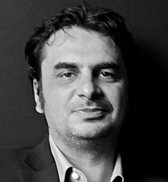|
One of the fundamental concepts I use in my consulting work is a set of two processes, with which you are all familiar from your daily life: individuality- the process of separating and becoming self-sufficient as a team, business, individual, or product. And fusion - the process of moving closer, or even merging, with larger crowds, teams, or organizations.
Human behavior is based on this ongoing dance between the need for individuality and fusion, and we transmit that to whatever we do. Like any creative endeavour, start-ups are also the result of successive fusions and separations. Entrepreneurs blend together their imagination, passion, purpose and lots of hard work, in a coherent, meaningful and fun product, which will carry all those qualities to their customers.
A fyuse is essentially a spatial photography able to reveal, with a smooth change of angles, a different identity of the same object than the one you initially see in a still image. In other words, the fyuse can dramatically change the viewers' perception, engaging them in a successive game of hiding and revealing.
It is this separation-fusion principle that I discussed with Radu Rusu, CEO and co-founder of Fyuse, an app . Rusu has a Ph.D. in Computer Science from the Technische Universitaet Muenchen (TUM), Germany (summa cum laude). During his Ph.D., he was affiliated with the Artificial Intelligence Center at Stanford Research Institute as an International Fellow Researcher, and with Willow Garage, working on 3D semantic mapping techniques for mobile robots. Our conversation revolved around neuronal networks and how the algorithmic process of "becoming" differs between humans and a machines. We both agreed that it might all have to do with our with peculiar need, as human beings, for both of these paradoxical states: individuality and fyusion. This might be actually the problem difficult to overcome when we are trying to build smart robots.
3D imaging is in fact similar to the creativity process: first we imagine or see something; and then we explore that "something" by sliding back and forth, left and right, up and down. Sometimes we enjoy the intimacy of the closeness to the subject of our perception. Other times we just need a fresh perspective, which only distance and separation can give us. The meaning, the reality of what is initially visible often changes completely as we circle around.
A friend described 3D photography as being "almost like a video". The key word here is almost. While not being a video nor a still picture, spatial photography has the combined psychological and aesthetic impact of both. It gives us the power of control, while at the same time it reserves us the complete surprise of what we could discover with each new angle. As receivers, we interact with the image received, but at the same time we are able to experience the same thing that the sender has experienced while taking that 3D image.
Swiss psychologist Jean Piaget was the first to demonstrate the crucial importance of "object constancy" in cognitive development: the ability of infants to understand that if the source of their safety and nurturing is not visible, it still exists. It is the endless game of peek-a-boo that teaches us that the world of people and objects continues to exist, even when our senses cannot detect it. The peek-a-boo of a Fyuse awakens in us the unconscious playfulness of what is not visible, but nonetheless exists.
British pediatrician and psychoanalyst D. W. Winnicott coined the term "transitional object": an object that mediates the transition between self and others, or otherwise said, between individuality and togetherness. It is the presence of transitional objects that teaches a child how to be creative and establish healthy relationships. The psychological power of spatial photography, therefore, resides in its ability to become a 3D transitional object, which fosters creativity and meaningful social interaction.
0 Comments
Leave a Reply. |
Cosmin Gheorghe"You never draw out of the deep of yourself that which you want; you always draw that which you are." Archives
November 2015
|


 RSS Feed
RSS Feed
